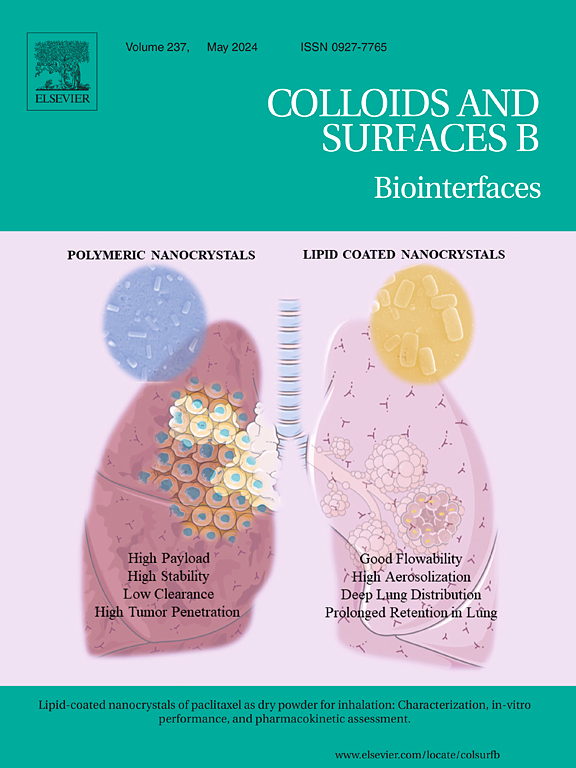Tuning structure and morphology of lipidic cubosomes by encapsulation of novel porphyrin-derivatives
IF 5.4
2区 医学
Q1 BIOPHYSICS
引用次数: 0
Abstract
Cubosomes are non-lamellar lipid nanoparticles that have drawn a significant attention in the field of nanomedicine due to their tunable properties. However, the formation of vesicles during the preparation of cubosomes, and the presence of mixed bicontinuous cubic phases, may lead to artifacts and lack of correlation between the physico-chemical and biological characterization. In this work, we have formulated cubosomes composed by monoolein as building block and triblock copolymer Pluronic® F108 as a stabilizer, encapsulating three porphyrin derivatives: two attached to bile acid moieties and one to a tetrapeptide to be used for potential theranostic applications. First, the effect of the cargo concentration (0.25, 0.50 and 1.00 mg/mL, for all three molecules) was evaluated on the structure, showing that the bile acid derivatives did not affect the self-assembly of the lipid providing only Pn3m phases; however, a mixed phase Pn3m + Im3m and a subsequent loss in crystallinity were induced by increasing concentrations of the tetrapeptide derivative. Overall, the encapsulation of the three molecules at 25 and 37 ∘C did not affect neither the hydrodynamic size nor the polydispersity of the cubosomes, influencing mainly the ζ-potential - positive in the case of the tetrapeptide and negative for the bile acid derivatives. The samples formulated with 0.50 mg/mL exhibited higher colloidal stability over time, with no significant changes in size or ζ-potential for over a month. Interestingly, the formulations containing the bile acid derivatives displayed the typical morphology of cubosomes in solution and a reduced number of vesicles (ca. 60:40 as cubosomes-to-vesicles ratio), whereas the sample containing the porphyrin attached to the tetrapeptide led to a ratio of cubosomes-to-vesicles estimated as 26:74, similar to the results of the empty formulation. The experiments at body temperature highlighted that the structure of the different formulations was not affected in a significant manner with retention of the phases observed at room temperature. The promising physico-chemical properties, especially at body temperature, could make these samples suitable as nanoplatforms for drug delivery applications.
立方体是一种非胶束脂质纳米颗粒,由于其可调整的特性,在纳米医学领域备受关注。然而,立方体在制备过程中形成的囊泡以及混合双连续立方相的存在,可能会导致物理化学表征与生物学表征之间缺乏相关性。在这项研究中,我们配制了由单烯作为结构单元、三嵌段共聚物 Pluronic® F108 作为稳定剂组成的立方体,其中封装了三种卟啉衍生物:两种与胆汁酸分子相连,一种与四肽相连,以用于潜在的治疗应用。首先,评估了货物浓度(三种分子的浓度分别为 0.25、0.50 和 1.00 毫克/毫升)对结构的影响,结果表明胆汁酸衍生物不会影响脂质的自组装,只会提供 Pn3m 相;然而,四肽衍生物浓度的增加会诱发 Pn3m + Im3m 混合相以及随后的结晶度下降。总之,在 25 和 37 ∘C 温度下封装这三种分子既不会影响立方体的流体力学尺寸,也不会影响立方体的多分散性,主要影响的是ζ电位--四肽为正,胆汁酸衍生物为负。用 0.50 毫克/毫升配制的样品随着时间的推移表现出更高的胶体稳定性,其大小或ζ电位在一个多月的时间里没有发生明显变化。有趣的是,含有胆汁酸衍生物的制剂在溶液中显示出典型的立方体形态,囊泡数量减少(立方体与囊泡的比例约为 60:40),而含有卟啉与四胜肽的样品导致立方体与囊泡的比例估计为 26:74,与空制剂的结果相似。在体温下进行的实验表明,不同配方的结构并未受到明显影响,在室温下仍能观察到不同的相。这些样品具有良好的物理化学特性,尤其是在体温下的物理化学特性,因此适合用作药物输送应用的纳米平台。
本文章由计算机程序翻译,如有差异,请以英文原文为准。
求助全文
约1分钟内获得全文
求助全文
来源期刊

Colloids and Surfaces B: Biointerfaces
生物-材料科学:生物材料
CiteScore
11.10
自引率
3.40%
发文量
730
审稿时长
42 days
期刊介绍:
Colloids and Surfaces B: Biointerfaces is an international journal devoted to fundamental and applied research on colloid and interfacial phenomena in relation to systems of biological origin, having particular relevance to the medical, pharmaceutical, biotechnological, food and cosmetic fields.
Submissions that: (1) deal solely with biological phenomena and do not describe the physico-chemical or colloid-chemical background and/or mechanism of the phenomena, and (2) deal solely with colloid/interfacial phenomena and do not have appropriate biological content or relevance, are outside the scope of the journal and will not be considered for publication.
The journal publishes regular research papers, reviews, short communications and invited perspective articles, called BioInterface Perspectives. The BioInterface Perspective provide researchers the opportunity to review their own work, as well as provide insight into the work of others that inspired and influenced the author. Regular articles should have a maximum total length of 6,000 words. In addition, a (combined) maximum of 8 normal-sized figures and/or tables is allowed (so for instance 3 tables and 5 figures). For multiple-panel figures each set of two panels equates to one figure. Short communications should not exceed half of the above. It is required to give on the article cover page a short statistical summary of the article listing the total number of words and tables/figures.
 求助内容:
求助内容: 应助结果提醒方式:
应助结果提醒方式:


